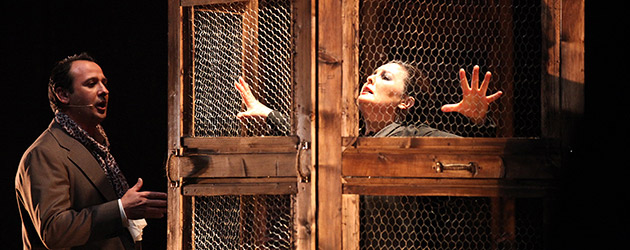Text: Estela Zatania
Photos: Ana Palma
Compañía María del Mar Moreno «Soníos Negros»
Saturday, March 7th, 2015. Jerez de la Frontera
Special 19th Festival de Jerez – All the information
THE FESTIVAL DE JEREZ 2015 COMES TO AN END
The nineteenth edition of the Festival de Jerez came to its conclusion last night after sixteen intense days. At the Don Antonio Chacón Flamenco Association, the group of Fernando Jiménez performed, and at the Guarida del Ángel, the great Capullo de Jerez put the icing on the cake after a lengthy series of daily shows held during the Festival.
Manuel Torre, «siempre por los rincones»
COMPAÑÍA MARÍA DEL MAR MORENO «SONÍOS NEGROS»
A flamenco drama approximation of the life and work of Manuel Torre based on the story «Paisaje Andaluz con Figuras» by Antonio Gala.
Teatro Villamarta, 9.00pm
Dance: María del Mar Moreno. Cante: Antonio Malena Manuel Malena, Antonio Peña «El Tolo». Guitar: Santiago Moreno, Antonio Malena hijo. Actresses: Ana Oliva, María Duarte. Palmas: Ale de Gitanería, Javier Peña. Cornet: Jesús Jiménez Padilla. Director: María del Mar Moreno. Music director: Santiago Moreno. Playwright: Paco Sánchez Múgica.
The last day of the Festival de Jerez, the majority of visitors from outside the city had left, and it was the perfect moment to indulge in the natural chauvinism all Jerez natives feel. And why not? And Jerez being the place that most cultivates siguiriyas, a work about the greatest interpreter of this form was just the right thing.
Dancer María del Mar Moreno has staged various works focusing on Jerez flamenco, but this one was different from the rest, possibly because it was based on the work of a playwright. «Soníos Negros»…the title comes from the famous phrase of Manuel Torre, «Todo lo que tiene soníos negros, tiene duende»…'Everything that has black sounds has the spirit of duende'…is structured like a narrated flashback. We see Antonia la Gamba, the elderly widow of Torre, telling anecdotes, remembering, complaining about Manuel…while María del Mar represents the stories with her dancing and acting, and she is cheered by the musicians as «Antonia», not «María». Greyhounds, pocket-watches and fighting cocks, the obsessions of the obsessive and unpredictable singer whose personality and genius have fascinated flamenco fans for a century. And that personality is expressed through soleá, alegrías, malagueña, saeta, taranto and farruca, but especially, siguiriyas, «a more meaningful way of breathing» as Antonio Gala writes in his work «Paisaje Andaluz con Figuras» that inspired this project.
As so often happens when a theatrical director gets involved in a show of dance and cante, flamenco gets upstaged by the demands of the script. The result tends to be a tug-of-war that is rarely won by flamenco. «Soníos Negros», the creation of playwright Paco Sánchez Múgica, is good theater, but as flamenco, it's less satisfying, if only because of the lack of contrast. The alegrías near the beginning of the show seem to promise a varied repertoire, and María's dancing shows an admirable attention to the aesthetic of the era, including an exquisitely historical wardrobe. But from there on, the pace of the work levels out and becomes monotone through to the end. The final scene is not a bulerías fiesta, but the burial of Manuel Torre.
Being the closing gala, we accept this sincere effort from serious hard-working people as a sentimental journey, and tribute to a much-admired Jerez flamenco artist that serves as the final flourish of the Festival de Jerez, 2015.
